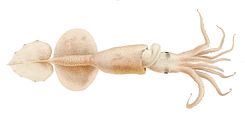Paralarva
Appearance


Grimalditeuthis bonplandi paralarva
Paralarvae (singular: paralarva) are young cephalopods in the planktonic stages between hatchling and subadult. This stage differs from the larval stage of animals that undergo true metamorphosis.[1] Paralarvae have been observed only in members of the orders Octopoda and Teuthida.[2]
The term was first introduced by Richard E. Young and Robert F. Harman in 1988.[2]
See also
References
- ^ "Paralarvae". Larval Images: Larval forms diverse and beautiful!.
- ^ a b Richard Edward Young & Robert F. Harman (1988). ""Larva", "Paralarva", and "Subadult" in Cephalopod Terminology". Malacologia. 29 (1): 201–207. Retrieved August 13, 2011.





